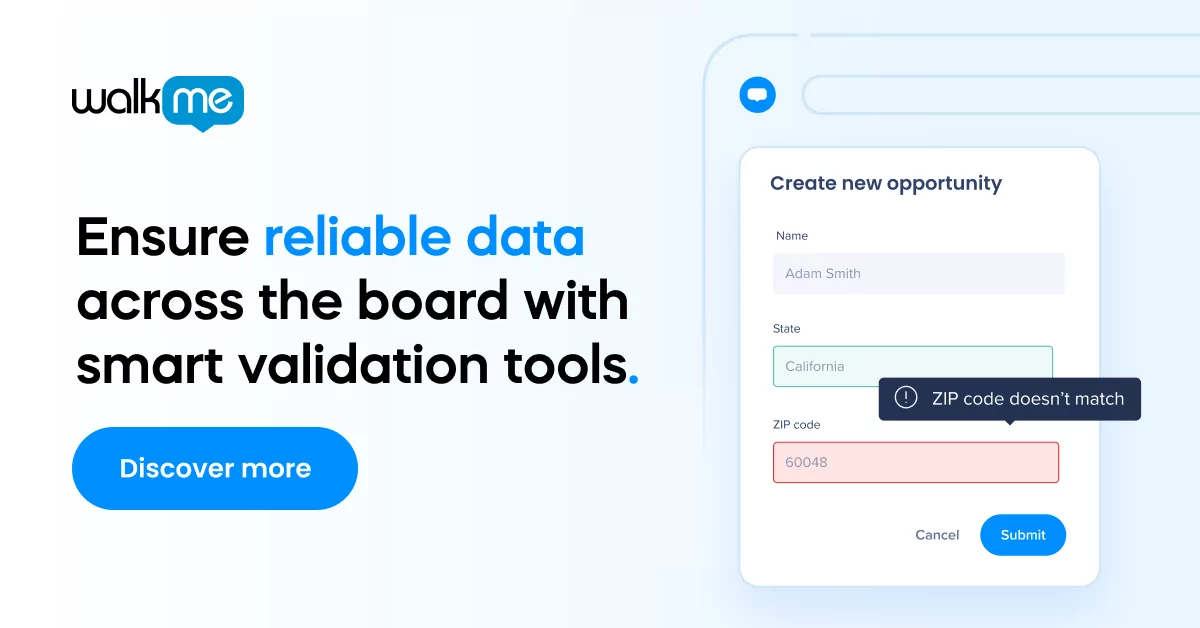If we’ve learned anything from these past couple of years, it is that we’re hurtling towards a digital-first future at turbo-speed—much faster than anyone had anticipated.
With tech playing such a critical role in how we work, shop, socialize and pretty much everything else we do, businesses are keen to hear what industry leaders have to say about digital adoption.
As you prepare for 2022 and beyond, we’ve assembled 6 digital adoption predictions from top analysts and a select few of our incredible WalkMe customers.
Discover how they view this upcoming year in terms of customer experience trends and digital adoption, and what our customers are taking into consideration as they shape their own company strategies.
1. “Digital dexterity is the new frontier“

As the Digital Learning Manager at EDF Renewables, I see 2022 as the year where employers—and employees—who have navigated COVID-19, the shift to work from home, and the Great Resignation must navigate a new frontier and shift from reactive to proactive. Whether they call it by name or not, this new frontier is going to be focused on the “Digital Dexterity” of teams and technology.
In my view, digital adoption relies on a user’s ability to utilize the technology that is at their fingertips…and then to accurately perform their tasks, provide feedback, and have a positive and delightful experience.
Digital Dexterity is a concept where the tenets of digital adoption are true for the software at a user’s disposal, but not only can they effectively use the tools in question, they can fluently and fluidly move between their applications to accomplish even greater efficiencies. We create Digital Dexterity by building consistent experiences across applications, embracing automation, taking a human-first approach to in-tool learning, and various other techniques.
Instead of reacting urgently and out of necessity, like most of us had to do in 2020 and 2021, in 2022, companies will be able to more thoughtfully and strategically design solutions that wholly address and respond to the shifting world of work. How? By taking the employee experience to an entirely new digitally fluid level, ensuring all the workforce accommodations and tech additions we made in 2020-21 work together and in sync, have user-friendly guidance and support, and decrease employees’ time to productivity.
When planning for 2022, I’m focused on how we can use our Digital Adoption Platform(s) to holistically analyze our systems, challenge the status quo, and further our commitment to Digital Dexterity in the workplace.
2. “Data about our systems and users holds the keys to enabling organizations”

Digital adoption is at the core of JobAdder’s learning department and it will continue to be an area of development going into 2022. Our goal is to ensure it is ingrained into our overall business strategy.
With remote working conditions continuing to be on the rise, it’s imperative Digital Adoption solutions equip both employees and clients with the support and resources they need to be successful from anywhere.
A Digital Adoption Platform such as WalkMe helps to fill the gap and provides useful data and analytics for continuous improvement. Data about our systems and users holds the keys to enabling organizations to truly meet employees and users where they are, both contextually and physically, in their moment of need.
This makes me excited about planning for 2022 because at the forefront of JobAdder’s culture are our customers and employees and being able to continue contributing to their success through the right digital experience, analytics and strategy.
3. “I expect a major push toward engaging and effective onboarding programs“

Based on my experience at LeaseAccelerator, I expect a major push toward engaging and effective onboarding programs that better enable companies to navigate new turnover trends (created by the Great Resignation).
I believe Human Resource Information Systems (HRIS) workflow and scalability strategies will need to include fully autonomous training solutions via Digital Adoption Platforms (DAP) to bridge the gap between the way systems are built (to suit the masses) and the realities of the processes and procedures that are unique to each business unit, function, and role within an organization.
Onboarding and change management programs across the full tech stack will demand remote delivery because work from home, and hybrid models are being used as enticements to attract quality candidates.
Those candidates will have high expectations for both the onboarding experience and their own performance thereafter. They’ll expect training that effectively gets them to productivity fast; which makes enablement a key feature for any delivery team.
Once hired, it’s our responsibility to prepare those employees with the correct resources and information. The benefit of using a Digital Adoption Platform is that we’re able to do so on their terms and at their pace.
It’s in anticipation of this evolution that I shift my focus to task/process mining and data driven lifecycle definitions with end-of-life thresholds for our WalkMe content.
In order to be scalable, our content must be accurate, effective, and accessible; and in order for our Digital Adoption strategy to be successful, it must accommodate delivery of that content in ways that are useful, timely, and relevant to the consumer—regardless of where they are, or when they were hired.
To top it off, here are a few analyst predictions that piqued our interest.
4. Gartner’s HCM prediction
By 2024, 60% of large, global organizations will try to address employee experience needs by deploying at least five Human Capital Management (HCM) and digital workplace technologies.
HR departments everywhere are struggling to cope with continuing workforce and economic disruption as the lingering effects of the pandemic unfold. The uneven nature of economic recovery by region and industry sector only adds complexity, and it has helped accelerate the emergence of “new normal” work methods and processes.
Additionally, some HR departments are facing the challenge of managing return-to-work initiatives for certain employee cohorts, while others are trying to limit attrition to reduce the strain on already overburdened recruiting functions.
Leveraging new work hubs with HCM opens up an additional channel to reach employees. It will be especially useful for HR teams by reducing the resources needed to support users who get ‘stuck’ when using the HCM application. End-user organizations that allow this feature can use it as an example of improving the employee experience.
*Source: Gartner, “Predicts 2022: HCM Technologies Enable Employee Experience to Support the “New Normal” of Work”, Ron Hanscome, Jeff Freyermuth, John Kostoulas, Chris Pang, Helen Poitevin, November 9, 2021.
Gartner disclaimer: GARTNER is registered trademark and service mark of Gartner, Inc. and/or its affiliates in the U.S. and internationally and is used herein with permission. All rights reserved.
5. Forrester’s employee experience prediction
“2022 will go down as the year executives were forced to care about EX.” The mantra that employee experience (EX) powers customer experience has been on leaders’ lips for years now. But the pandemic made it clear first to employees and then gradually to their exec leaders that without robust EX, workers can and will take their skills elsewhere.
Between failing at so-called “remote” work (which is now just work) and struggling to escape the compliance-heavy approach to HR that has plagued companies for years, 2022 will be a decisive year as C-level execs finally admit that the future of work they had envisioned coming out of the pandemic will remain elusive unless they commit to EX. Fortunately for the few who accepted this years ago, 2022 will be their time to shine.
* Source: Forrester Report, Predictions 2022: The Future Of Work, November 2, 2021.
6. Forrester’s all-digital prediction
The majority of consumers will see the world as all-digital, with no divide.
“In 2022, business leaders will invest in technology and refocus business strategies. AI adoption and tech spending will accelerate. Tech companies will jump into adjacent markets, equally capitalizing on opportunity and sowing confusion. Greenwashing will wash away as sustainability becomes a must-have. 2022 is a year to be bold. The old ways of working no longer work. The future is up for grabs. Leading firms will use the crucibles of 2020 and 2021 to forge a path to an agile, creative, and resilient tomorrow.
* Source: Forrester’s Predictions 2022, North America Guide.
Hope you enjoyed our top predictions for the future of digital adoption in 2022 and beyond. If you want to learn more about WalkMe and digital adoption, subscribe to our blog.


